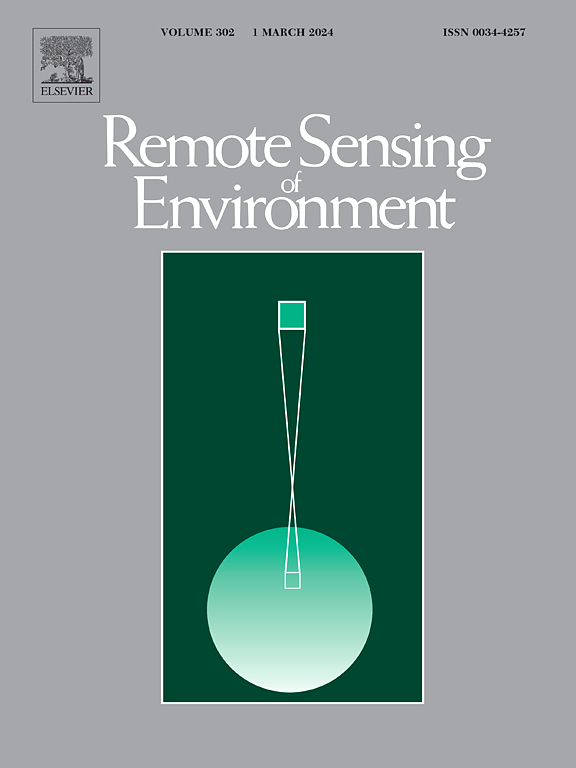Mapping large-scale pantropical forest canopy height by integrating GEDI lidar and TanDEM-X InSAR data
IF 11.1
1区 地球科学
Q1 ENVIRONMENTAL SCIENCES
引用次数: 0
Abstract
NASA's Global Ecosystem Dynamic Investigation (GEDI) mission provides billions of lidar samples of canopy structure over the Earth's temperate and pantropical forests. Using the GEDI sample data alone, gridded height and biomass products have been created at a spatial resolution of 1 km or coarser. However, this resolution may be too coarse for some applications. In this study, we present a new method of mapping high spatial resolution forest height across large areas using fusion of data acquired by GEDI and TanDEM-X (TDX) Interferometric Synthetic Aperture Radar (InSAR). Our method utilizes GEDI waveforms to provide vertical profiles of scatterers needed to invert a physically-based InSAR model to solve for canopy height. We then use 2-year GEDI canopy height and adaptive wavenumber (kZ)-based calibration models to reduce errors in the inverted canopy height caused by the limited penetration capability of the X-band signal in dense tropical forests and the impact of terrain. We apply this novel method over large areas including Gabon, Mexico, French Guiana and most of the Amazon basin, and generate continuous forest height products at 25 m and 100 m. After validating against airborne lidar data, we find that our canopy height products have a bias of 0.31 m and 0.46 m, and a root mean square error (RMSE) of 8.48 m (30.02 %) and 6.91 m (24.08 %) at 25 m and 100 m respectively, for all sites combined. Compared to existing data products that integrate GEDI with passive optical data using machine learning approaches, our method reduces bias, has a lower RMSE, and does not saturate for tall canopy heights up to 56 m. A key feature of this study is that our canopy height product is complemented with an uncertainty of prediction map which provides information on the predictor's uncertainty around the actual value —an advancement over the standard error maps used in earlier studies, which provide uncertainty around the expectation of the predicted value. This integration approach enables the first-ever accurate and high-resolution mapping of forest canopy heights at unprecedented large areas from GEDI and TDX InSAR data fusion, serving as an essential foundation for pantropical aboveground biomass mapping.
基于GEDI激光雷达和TanDEM-X InSAR数据的大尺度泛热带森林冠层高度制图
NASA的全球生态系统动态调查(GEDI)任务提供了数十亿份地球温带和泛热带森林树冠结构的激光雷达样本。仅使用GEDI样本数据,网格化的高度和生物量产品已在1公里或更大的空间分辨率下创建。然而,这个分辨率对于某些应用程序来说可能太粗糙了。在这项研究中,我们提出了一种利用GEDI和TanDEM-X (TDX)干涉合成孔径雷达(InSAR)获取的数据融合来绘制大面积高空间分辨率森林高度的新方法。我们的方法利用GEDI波形来提供散射体的垂直剖面,这些散射体需要用于反演基于物理的InSAR模型来求解冠层高度。然后,利用2年GEDI冠层高度和基于自适应波数(kZ)的校准模型,降低由于x波段信号在茂密的热带森林中穿透能力有限和地形影响而导致的反演冠层高度误差。我们将这种新方法应用于包括加蓬、墨西哥、法属圭亚那和亚马逊盆地大部分地区在内的大片地区,并在25米和100米处生成连续的森林高度产品。在对机载激光雷达数据进行验证后,我们发现我们的冠层高度产品偏差为0.31 m和0.46 m,均方根误差(RMSE)分别为8.48 m(30.2%)和6.91 m(24.08%),在所有站点组合的25 m和100 m。与使用机器学习方法将GEDI与被动光学数据集成在一起的现有数据产品相比,我们的方法减少了偏差,具有更低的RMSE,并且在高达56 m的高树冠高度下不会饱和。本研究的一个关键特征是,我们的冠层高度产品与预测的不确定性图相辅相成,该图提供了预测者对实际值的不确定性的信息,这是比早期研究中使用的标准误差图的进步,后者提供了对预测值期望的不确定性。这种整合方法使GEDI和TDX InSAR数据融合能够在前所未有的大范围内首次精确和高分辨率地绘制森林冠层高度图,为泛热带地上生物量制图奠定了重要基础。
本文章由计算机程序翻译,如有差异,请以英文原文为准。
求助全文
约1分钟内获得全文
求助全文
来源期刊

Remote Sensing of Environment
环境科学-成像科学与照相技术
CiteScore
25.10
自引率
8.90%
发文量
455
审稿时长
53 days
期刊介绍:
Remote Sensing of Environment (RSE) serves the Earth observation community by disseminating results on the theory, science, applications, and technology that contribute to advancing the field of remote sensing. With a thoroughly interdisciplinary approach, RSE encompasses terrestrial, oceanic, and atmospheric sensing.
The journal emphasizes biophysical and quantitative approaches to remote sensing at local to global scales, covering a diverse range of applications and techniques.
RSE serves as a vital platform for the exchange of knowledge and advancements in the dynamic field of remote sensing.
 求助内容:
求助内容: 应助结果提醒方式:
应助结果提醒方式:


